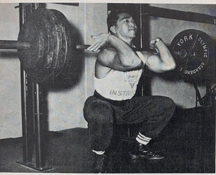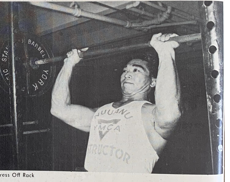Thanks again, Brother. Screw the BS and bozos and
have yourself a great Christmas.
In a recent conversation in York, Tommy Kono gave me some of his opinions on correct preparation for important competition. These opinions are the result of over a decade of big league competition, and as they have brought him eight World championships, three Pan-American championships, and have enabled him to establish, in four weight classes more world records than any other weightlifter in history, all young and all aspiring lifters can benefit from his sage advice. I give you Tommy's words just as he gave them to me.
"Back in 1952 when I was stationed in Germany after winning the Olympic lightweight crown, I was able to equal and exceed world record totals almost every weekend by following a simple 1-1/4 hour, tri-weekly training session.
"My workout consisted of Presses and Snatches performed 3 repetitions per set for 7 to 8 sets, 4 to 6 singles in the Clean, followed by 3 x 3 in the Squat . My mind and body were so receptive at this stage of my lifting career that I was able to make steady gains by following such an uncomplicated training course.
"As the years rolled on a more diversified program was needed to inject enthusiasm into my training. The effectiveness of the simple routine of press, snatch, clean, and squat WAS LESSENED BY MONOTONY, and therefore a different approach to the three lifts was required to continue progress.
"The easiest and most logical program I resorted to was a course consisting of exercises similar to the three Olympic lifts which developed the same neuromuscular strength and coordination as the three lifts. I broke the lifts down to their basic components of pushing and pulling and specialized on increasing the basic power of the muscles required in the back, shoulders, legs, and arms.
"Eventually a training routine evolved for my purpose. I developed two courses, the first of which lasts from three to six weeks, depending on how much preliminary training I need at that particular time before I go into the three lifts. This part of the program is more or less a prelude to the more advanced work which is performed during the second course of the routine.
"The first course generally takes 1-1/2 hours to complete and is performed three times a week on nonconsecutive days. A sample workout of this nature would be as follows:
COURSE ONE
1) Warmup - 2 sets of hanging leg raises, 20 reps.
2) Wide Grip Military Press:
135x5, 185x5, 205x5, 225x5, 245x5
3) Power Snatch:
135x3, 155x3, 165x3
4) Power Clean:
205x3, 225x3, 235x3, 245x3
5) Snatch Grip High Pull:
285x3, 295x3, 305x3
6) Clean Grip High Pull:
325x3, 345x3, 355x3
7) Squat:
325x5, 365x3, 385x3, 385x3
"This preparatory period of my "power program" concluded, I go into the second part of the two-part course, which lasts two to three weeks. The second course is split into two routines; i.e., pull and leg work on one day, and press work the following day.
COURSE TWO
Part One (Mon/Wed/Fri) -- 1-1/2 to 1-3/4 hours.
1) Warmup:
2 sets of hanging leg raises, 20 reps
2) Power Clean:
135x3, 185x3, 205x3, 235x3, 255x3
3) Squat Clean:
135x3, 225x1, 275x1, 305x1, 325x1, 345x1
4) Clean Grip High Pull:
325x3, 345x3, 365x3
5) Power Snatch:
135x3, 155x3, 175x3
6) Squat Snatch:
135x3, 185x3, 205x2, 225x2, 245x1, 255x1, 255x1
7) Snatch Grip High Pull:
285x3, 305x3, 315x3
8) Front Squat:
295x3, 345x3, 365x3, 385x3
COURSE TWO
Part Two (Tues/Thurs/Sat) 35 to 45 minutes
1) Press Off Rack:
135x3, 205x3, 225x3, 245x3, 265x3, 285x3, 285x3, 285x3
2) Bench Press:
255x3, 305x3, 335x3
"Following the above program over the prescribed period of time and using the poundages listed, i am then ready for a contest approximately a week away with the possible chance of totaling between 980 and 1,000 with 325-330 Press, 280-290 Snatch, and 375-380 Clean & Jerk.
"I never train all year around on the three lifts because after so many years of lifting I find I can very easily become bored and try to handle heavy weights all the time. One of the keys to success, ONE OF THE KEYS TO SUCCESS is the ability to maintain enthusiasm in what you are trying to accomplish. [You can't get into it if you can't get up.] Boredom in training must be avoided at all costs if progress is to be achieved. Sometimes i perform a bodybuilding workout [horrors!] about a week before an important weightlifting meet just to break the monotony and maintain muscle tone without becoming over-trained on the Olympic lifts.
"No lifter can acquire any measure of success unless he has a positive approach to the sport. The mind plays such a vital role in achieving success or failure that it makes me wonder why this point hasn't been received more stress I know that men such as Isaac Berger, Norbert Schemansky, and Pete George possess this quality and have developed it to an amazing degree. I've had the pleasure of being their teammate a number of times and had the opportunity to see this quality come to light in numerous training sessions and also on the platform when they needed a particular lift.
"The MIND creates the goal and the BODY accomplishes the task. My approach in strengthening the ability of the mind to think positively is to mentally condition myself for each workout. I plan a workout in advance and I attempt to perform all the required reps and sets with the required weights. Success breeds success!
"Another important subject for successful lifting is diet. Basically I try to live on a protein-rich diet with adequate amounts of vitamins and minerals. I include protein supplements and . . . we'll just skip this part.
"When I lifted as a lightweight, I would weigh as high as 158 and trim down to the 148 pound class and have "beefed" myself up to 186 pounds. There is no secret in gaining or losing bodyfat. Anyone can fluctuate their weight if they have desire and really put effort behind it -- but to reduce an already muscular body and still retain power, or to gain bodyweight and show proportionate increases in power without losing speed or timing is another matter. A correct diet with adequate-for-the-task protein, vitamins and minerals is the real secret in reducing bodyweight while increasing power. It is also the secret in increasing bodyweight while lifting proportionately better.
"My advice to the lifters that are new to the game is to remember that training is but one of the many facets in improving your total on the three Olympic lifts. Diet and your mental approach are equally as important -- and do not discount the importance of sleep and relaxation."
Enjoy Your Lifting!




No comments:
Post a Comment